Updating My Rails Project with Javascipt
I had a lot of fun building my first rails app a few weeks ago. Now it’s time to go back over the project and add in some functionality with javascript. I used jQuery to build some front end elements here.
You can see a quick run through of this code in action here, or in the nifty gifs below. This is a longer post because I learned a lot here.
Rendering Rails Model Data in JSON
There’s three simple steps to turn rails data models into JSON.
First, I added the ‘active_model_serializers’ gem to the gemfile and ran bundle install and rails g serializer (modelname) for each model I wanted to serialize. Then in App > Serializers I edited the serializer format to include the data I needed.
class RecipeSerializer < ActiveModel::Serializer
attributes :id, :name, :description, :user_id, :rating
has_many :ingredients
end
To render this data in the view, we can add the following into the controller instead of simply ‘render :show’.
def show
...
respond_to do |format|
format.html {render :show}
format.json {render json:@recipe}
end
end
So now when I go to /recipes/:id.json, the JSON object is there, waiting to be parsed!
To accomplish my goals on this lab, I serialized recipes, ingredients and comments.
Grabbing Data with $.getJSON
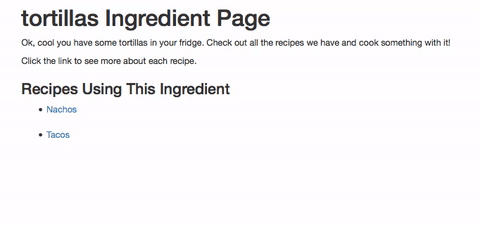
I create page specific javascript using <%= content_for :ingredient do %> in my views.
As you can see in the gif above, I added a click event to the ingredient show page, which grabs the JSON. It then gets parsed and displayed. So the recipe show page is rendered within another page, with the options to read more or hide the information.
var linkOverride = function() {
$("a#recipe").click(function(event) {
event.preventDefault(); // prevent link from clicking through
loadRecipes(event["target"]["href"]); // pass link to loadRecipes method
});
};
function loadRecipes(target_url) {
$.getJSON (target_url + ".json", function(result) { // add .json to the url
handleResponse(result); // pass off to handle the response
})
};
Creating New Data with $.Ajax Requests
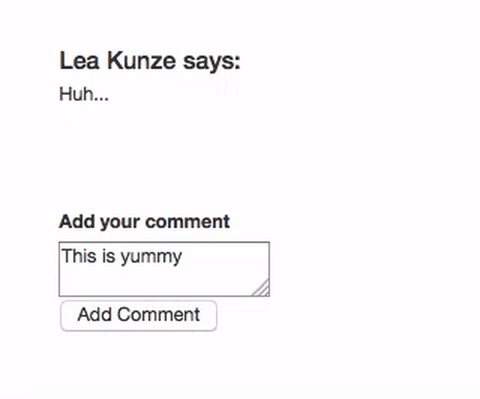
Getting a little more complex now, I built instant comment functionality. A user adds a new comment, which makes an Ajax request to create the comment.
At the same time, the comment is instantly rendered on the page and the comment box is hidden, limiting recipes to having one comment per user per visit.
I utilized the magic of the serialize() method, which passes the form submission as serialized data, which rails is ready to process.
The code to accomplish this:
var createMethods = function() {
$('div#new_comment form').on("submit", function(event) { // identifying the form with jQuery selectors
event.preventDefault(); // prevent form from submitting
var recipe_id = event['currentTarget']['4']['value']; // grab recipe ID from the event
var values = $(this).serialize(); // I understand this magic.
$.ajax({ // post serialized data to the restful route
url: "http://localhost:3000/recipes/" + recipe_id + "/comments/",
method: 'post',
data: values,
dataType: 'json'
}).done(function(data) { // when done, render that comment instantly on the page.
$('div#new_comment form').hide();
$('.newUser').text("<%= current_user.name %>" + " says:");
$('#newComment').text(data['content']);
});
})
}
Editing and Updating Data with $.Ajax
I used similar code to edit, update and delete comments. The structure is basically the same as above, so check out the functionality and comments for each one.
Editing Comments
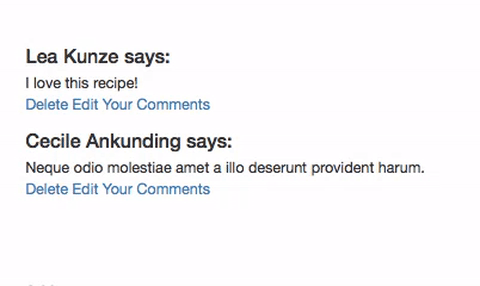
The edit comment form is hidden with CSS and needs to be shown conditionally when a user clicks on the edit link. The most difficult part about editing comments in this way was selecting the exact comment to show only that form.
I accomplished this by passing the comment ID into the class, so each comment and form was within a unique class, like .commentos-64.
# views/comments/index.html.erb
<div class="commentos-<%= comment.id %>">
<%= comment.content %>
<form id="edit_comment_form">
<%= text_field_tag :content, comment.content %><br>
<%= hidden_field_tag :user_id, current_user.id %>
<%= hidden_field_tag :recipe_id, @recipe.id %>
<%= hidden_field_tag :id, comment.id %>
<%= submit_tag "Edit", id: :submit_edit %>
</form>
</div>
After much tinkering, the key was to stop using generic class-based selectors (#edit_comment_form) and to dig out the next sibling, parent node of the click event, which was the that form specifically: .commentos-(id) form. Then the CSS of the form is switched to show, allowing a user to edit the comment.
Deleting Comments
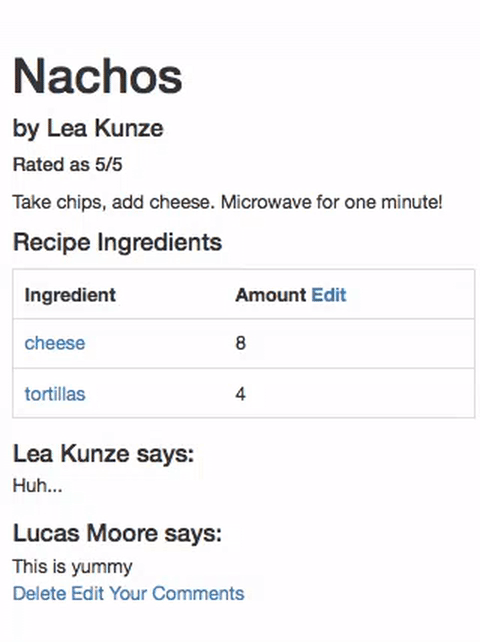
I wanted to have a confirmation prompt, to ensure a user meant to delete their comment. If they say yes, the logic to delete the comment is executed.
var deleteMethods = function() {
$('a#delete').on("click", function(event) {
event.preventDefault();
var url = event['target']['href'];
var result = confirm("Are you sure?"); // tied confirmation to a variable
if(result) { //only if the variable returns true, execute deletion
$.ajax({
url: url,
method: 'delete'
}).done(deleteResponse(event));
}
});
}
var deleteResponse = function(event) { //overwrite comment with deleted message
var comment = event['target']['parentElement'];
$(comment).text("Comment Deleted");
} // the comment will disappear upon page refresh
Updating RecipeIngredients
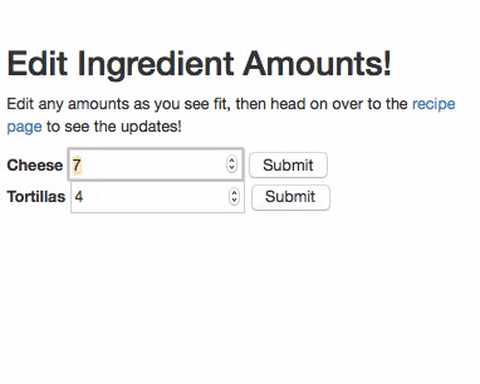
I also wrote the functionality to update the quantity of ingredients in a recipe, which is stored in a RecipeIngredients join table. A simple alert pops up to show that the update was successful.
So What Now?
I am just starting to get my hands dirty with javascript. I have a lot more to learn. I understand that a user could edit anyones comments by manipulating the CSS of the comment edit form, showing it and updating the comment. I have some ideas of how to fix that in my next update.
But mostly, I am excited to finally understand all of these interconnected parts of a web application. Rails for the backend, HTML and CSS in the view, Javascript for front end logic. Seeing this security flaw is a step forward.
By the way, I made these rad gifs with the giphy capture tool.